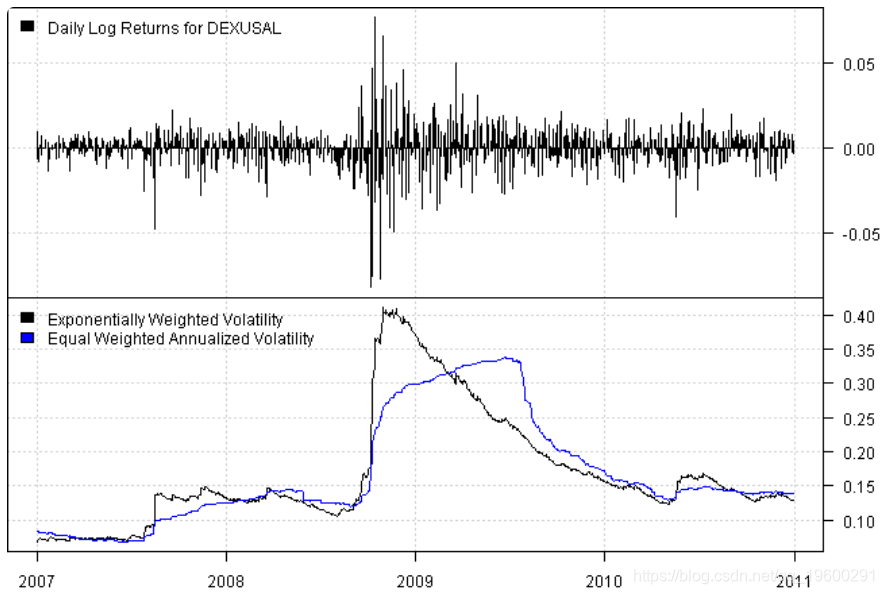拓端tecdat|R语言中使用RCPP并行计算指数加权波动率
原文链接:http://tecdat.cn/?p=17829
指数加权波动率是一种波动率的度量,它使最近的观察结果有更高权重。我们将使用以下公式计算指数加权波动率:
S [t] ^ 2 = SUM(1-a)* a ^ i *(r [t-1-i]-rhat [t])^ 2,i = 0…inf
其中rhat [t]是对应的指数加权平均值
rhat [t] = SUM(1-a)* a ^ i * r [t-1-i],i = 0…inf
上面的公式取决于每个时间点的完整价格历史记录,并花了一些时间进行计算。因此,我想分享Rcpp和RcppParallel如何帮助我们减少计算时间。
我将使用汇率的历史数据集 作为测试数据。
首先,我们计算平均滚动波动率
-
#*****************************************************************
-
# 计算对数收益率
-
#*****************************************************************
-
ret = diff(log(data$prices))
-
-
tic(5)
-
hist.vol = sqrt(252) * bt.apply.matrix(ret, runSD, n = 200)
-
toc(5)
经过时间为0.17秒
接下来,让我们编写指数加权代码逻辑
-
# 建立 RCPP 函数计算指数加权波动率
-
load.packages('Rcpp')
-
sourceCpp(code='
-
#include <Rcpp.h>
-
using namespace Rcpp;
-
using namespace std;
-
-
// [[Rcpp::plugins(cpp11)]]
-
-
//ema[1] = 0
-
//ema[t] = (1-a)*r[t-1] + (1-a)*a*ema[t-1]
-
// [[Rcpp::exp
-
-
{
-
if(!NumericVector::is_na(x[t])) break;
-
res[t] = NA_REAL;
-
}
-
int start_t = t;
-
-
-a) * a^i * (r[t-1-i] - rhat[t])^2, i=0 ... inf
-
// [[Rcpp::export]]
-
NumericVector run_esd_cpp(NumericVector x, double ratio) {
-
auto sz = x.siz
-
-
// find start index; first non NA item
-
for(t = 0; t < sz; t++) {
-
if(!Num
-
0;
-
for(t = start_t + 1; t < sz; t++) {
-
ema = (1-ratio) * ( x[t-1] + ratio * ema);
-
double sigma = 0;
-
for(int i = 0; i < (t - start_t); i++) {
-
sigma += pow(ratio,i) * pow(x[t-1-i] - ema, 2);
-
}
-
res[t] = (1-ratio) * sigma;
-
}
-
, n, ratio = n/(n+1)) run_ema_cpp(x, ratio)
-
run.esd = funct
经过时间为106.16秒。
执行此代码花了一段时间。但是,代码可以并行运行。以下是RcppParallel版本。
-
# 建立 RCPP 并行函数计算指数加权波动率
-
load.packages('RcppParallel')
-
sourceCpp(code='
-
-
using namespace Rcpp;
-
using namespace s
-
s(cpp11)]]
-
// [[Rcpp::depends(R
-
to read from
-
const RMatrix<double> mat;
-
// internal variables
-
const double ratio
-
t;
-
// initialize from Rcpp input and output matrixes
-
run_esd_helper(const Nume
-
all operator that work for th
-
-
in, size_t end) {
-
for (size_t c1 = begin; c1 < end; c1++) {
-
int t;
-
// find start index; fir
经过时间为14.65秒
运行时间更短。接下来,让我们直观地了解使用指数加权波动率的影响
-
dates = '2007::2010'
-
layout(1:2)
-
e='h', col='black', plotX=F)
-
plota.legend(paste('Dai
-
s,1],type='l',col='black')
-
-
-

不出所料,指数加权波动率在最近的观察结果中占了更大的比重,是一种更具反应性的风险度量。

最受欢迎的见解
1.HAR-RV-J与递归神经网络(RNN)混合模型预测和交易大型股票指数的高频波动率
2.WinBUGS对多元随机波动率模型:贝叶斯估计与模型比较
4.R语言ARMA-EGARCH模型、集成预测算法对SPX实际波动率进行预测
▍关注我们
【大数据部落】第三方数据服务提供商,提供全面的统计分析与数据挖掘咨询服务,为客户定制个性化的数据解决方案与行业报告等。
▍咨询链接:http://y0.cn/teradat
▍联系邮箱:3025393450@qq.com





